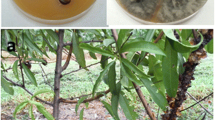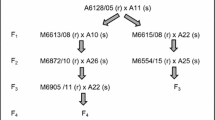Abstract.
Powdery mildew, caused by Podosphaera pannosa, is one of the most-severe diseases of roses grown under glass. The differentiation into physiological races and the genetic analysis of resistance in a segregating host population was investigated using single conidial isolates of the pathogen. Using ten rose genotypes, all eight isolates of the pathogen could be ascribed to different races. Five races were isolated from one location, which indicates that populations of P. pannosa exhibit a high racial diversity. Infection experiments in a backcross-population of 114 rose plants resulted in a 1:1 segregation, suggesting control by a single dominant gene. Rpp1 is the first resistance gene against rose powdery mildew to be described.


Similar content being viewed by others
References
Andrivon D, De Vallavieille-Pope C (1993) Racial diversity and complexity in regional populations of Erysiphe graminis f.sp. horde i in France over a 5-year period. Plant Pathol 42:443–464
Atkiss L (1978) Disease resistant rose varieties. American rose annual, pp 99–104
Bender CL, Coyier DL (1984) Isolation and identification of races of Sphaerotheca pannosa var. rosae Phythopathology 74:100–103
Bevan JR, Crute IR, Clarke DD (1993) Variation for virulence in Erysiphe fischeri from Senecio vulgaris. Plant Pathol 42:622–635
Bousset L, Hovmøller MS, Caffier V, de Vallavielle-Pope C, Østergård H (2002) Observed and predicted changes over 8 years in the frequency of barley powdery mildew avirulent to spring barley in France and Denmark. Plant Pathol 51:33–44
Braun PW, Turgut I (1995) The virulence structure of mildew populations on wild barley in Turkey. J Plant Dis Protection 102:593–598
Braun U, Takamatsu S (2000) Phylogeny of Erysiphe, Microsphaera, Uncinula (Erysipheae) and Cystotheca, Podosphaera, Sphaerotheca (Cystotheceae) inferred from rDNA ITS sequences – some taxonomic consequences. Schlechtendalia 4:1–33
Conti GG, Bassi M, Maffi D, Bonecchi R (1985) Host-parasite relationship in a susceptible and a resistant rose cultivar inoculated with Sphaerotheca pannosa. I. Fungal growth, mechanical barriers and Hypersensitive Response. Phythopathology 113:71–80
Conti GG, Bassi M, Maffi D, Bocci AM (1986) Host-parasite relationship in a susceptible and a resistant rose cultivar inoculated with Sphaerotheca pannosa. II. Deposition rates of callose, lignin and phenolics in infected or wounded cells and their possible role in resistance. Phythopathology 117:312–320
Debener T, Drewez-Alvarez R, Rockstroh K (1998) Identification of five physiological races of black spot, Diplocarpon rosae, Wolf on roses. Plant Breed 117:267–270
Debener T, Mattiesch L (1999) Construction of a genetic linkage map for roses using RAPD and AFLP markers. Theor Appl Genet 99:891–899
Dohm A, Ludwig C, Nehring K, Debener T (2001) Somatic embryogenesis in roses. Acta Hort 547:341–348
Ferrero F, Cadour-Marvaldi P, Jacob Y, Coudret A, Sallanon H, Urban L (2001a) Evaluation of the resistance to powdery mildew, Sphaerotheca pannosa var. rosae, of rose-tree species and hybrids. A. Biological test on excised leaflets, microscopic observations of the fungus, physical evaluation of the leaf cuticle protection. Acta Hort 547:379–381
Ferrero F, Cadour-Marvaldi P, Guiloteau E, Jacob Y, Coudret A, Sallanon H (2001b) Evaluation of the resistance to powdery mildew, Sphaerotheca pannosa var. rosae, of rose-tree species and hybrids. B. First exploitation of the resistance biodiversity in a crossing program on resistance. Acta Hort 547:379–381
Flor HH (1942) Inheritance of pathogenicity in Melampsora lini. Phythopathology 32:653–669
Geiger HH, Heun M (1989) Genetics of quantitative resistance to fungal diseases. Annu Rev Phytopathol 27:317–341
Gudin S (2000) Rose: genetics and breeding. Plant Breed Rev 17:159–189
Hajlaoui MR, Benhamou N, Bélanger RR (1991) Cytochemical aspects of fungal penetration, haustorium formation and interfacial material in rose leaves infected by Sphaerotheca pannosa var. rosae. Phys Mol Plant Pathology 39:341–355
Horst RK (1983) Compendium of rose diseases. American Phytopathol Soc, St Paul
Jorgensen (1994) Genetics of powdery mildew resistance in barley. Crit Rev Plant Sci 13:79–119
Keller B, Feuillet C, Messmer M (2000) Genetics of disease resistance: basic concepts and application in resistance breeding. In: Slusarenko AJ, Fraser RSS, van Loon LC (eds) Mechanisms of resistance to plant diseases. Kluwer Acad. Publ., Dordrecht Boston London, pp 101–136
Leus L, Van Huylenbroeck J, Van Bockstaele E (2002) Powdery mildew on roses: Pathotype screening. In: Van Huylenbroeck J, Van Bockstaele E, Debergh P (eds) Proc. XX EUCARPIA Symposium on New Ornamentals II. Acta Hort 572:91–95
Linde M, Shishkoff N (2003) Fungi; powdery mildew. In: Roberts A, Gudin S, Debener T (eds) Encyclopedia of rose science. Academic Press Ltd, London (in press)
Malek von B, Debener T (1998) Genetic analysis of resistance to black spot (Diplocarpon rosae) in tetraploid roses. Theor Appl Genet 96:228–231
Mence MJ, Hildebrandt AC (1966) Resistance to powdery mildew in rose. Ann Appl Biol 58:309–320
Murashige T, Skoog F (1962) A revised medium for rapid growth and bio assays with tobacco tissue cultures. Physiol Plant 15:473–497
Paulitz CT, Bélanger RR (2001) Biological control in greenhouse systems. Annu Rev Phytopathol 39:103–133
Perera RG, Wheeler BEJ (1975) Effect of water droplets on the development of Sphaerotheca pannosa on rose leaves. Trans Br Mycol Soc 64:313–319
Price TV (1970) Epidemiology and control of powdery mildew (Sphaerotheca pannosa) on roses. Ann Appl Biol 65:231–248
Vakalounakis DJ, Klironomou E (1995) Race and mating type identification of powdery mildew on cucurbits in Greece. Plant Pathal 44:1033–1038
Vanderplank JE (1978) Genetic and molecular basis of plant pathogenesis. Springer Verlag, Berlin Heidelberg New York
Weinhold AR (1961a) The orchard development of peach powdery mildew. Phythopathology 51:478–481
Weinhold AR (1961b) Temperature and moisture requirements for germination of conidia of Sphaerotheca pannosa from peach. Phythopathology 51:699–703
Wolfe MS, McDermott JM (1994) Population genetics of plant pathogen interactions: the example of the Erysiphe graminis-Hordeum vulgare pathosystem. Annu Rev Phytopathol 32:89–113
Xu X-M (1999) Effects of temperature on the latent period of the rose powdery mildew pathogen, Sphaerotheca pannosa. Plant Pathol 48:662–667
Yarwood CE (1952) Apricot powdery mildew from rose and peach. Calif Dept Agric Bull 41:19–25
Yokoya K, Kandasamy KI, Walker S, Mandegaran Z, Roberts AV (2000) Resistance of roses to pathotypes of Diplocarpon rosae. Ann Appl Biol 136:15–20
Acknowledgements
This project was supported by a grant of the Ministry of Economics, Technology and Transport of the Land Schleswig-Holstein, and by the companies W. Kordes Söhne (Germany) and Rosen Tantau (Germany). We thank K. Sabin for valuable technical assistance and Prof. A. Roberts (UEL, London) for critically reading the manuscript.
Author information
Authors and Affiliations
Corresponding author
Additional information
Communicated by F. Salamini
Rights and permissions
About this article
Cite this article
Linde, M., Debener, T. Isolation and identification of eight races of powdery mildew of roses (Podosphaera pannosa) (Wallr.: Fr.) de Bary and the genetic analysis of the resistance gene Rpp1. Theor Appl Genet 107, 256–262 (2003). https://doi.org/10.1007/s00122-003-1240-1
Received:
Accepted:
Published:
Issue Date:
DOI: https://doi.org/10.1007/s00122-003-1240-1




